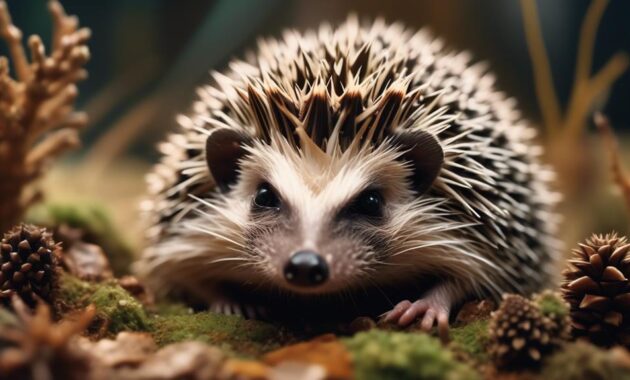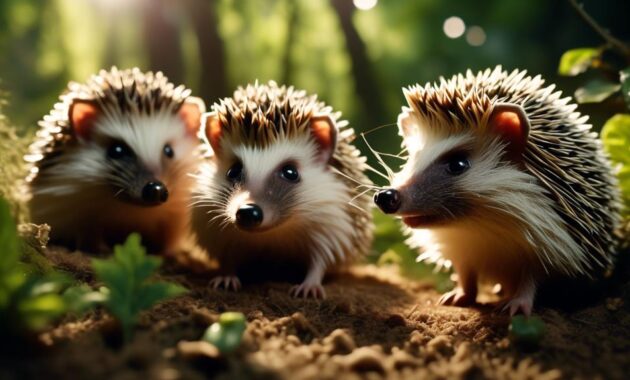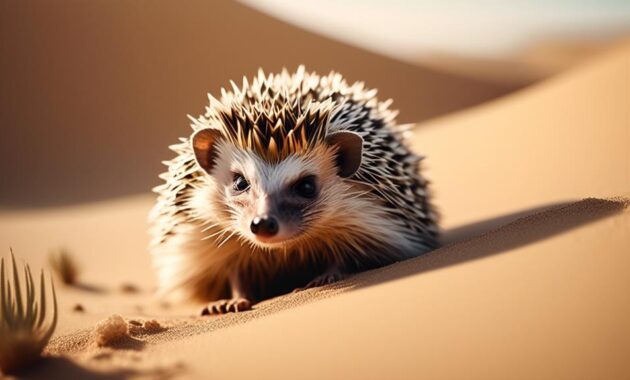
The southern African hedgehog, also known as Atelerix frontalis, is an intriguing creature that roams the savannas, grasslands, and woodlands of southern Africa. With its spiky exterior and enigmatic nature, this species has captivated the attention of researchers and conservationists alike.
However, there is much more to these guardians of the African landscape than meets the eye. From their unique reproductive behavior to their crucial ecological role, the southern African hedgehog holds many secrets waiting to be unveiled.
In this discussion, we will explore the fascinating world of these enigmatic creatures, shedding light on their importance in maintaining the balance of southern African ecosystems.
Key Takeaways
- Southern African hedgehogs are nocturnal creatures that rely on their sense of smell to locate prey.
- They are proficient diggers and create burrows for shelter and protection.
- Their spiky defense mechanism, curling up into a ball, helps protect them from predators.
- Southern African hedgehogs play important ecological roles as insectivores, seed dispersers, and prey for larger predators, contributing to the overall health and balance of their habitats.
Southern African Hedgehog: An Overview
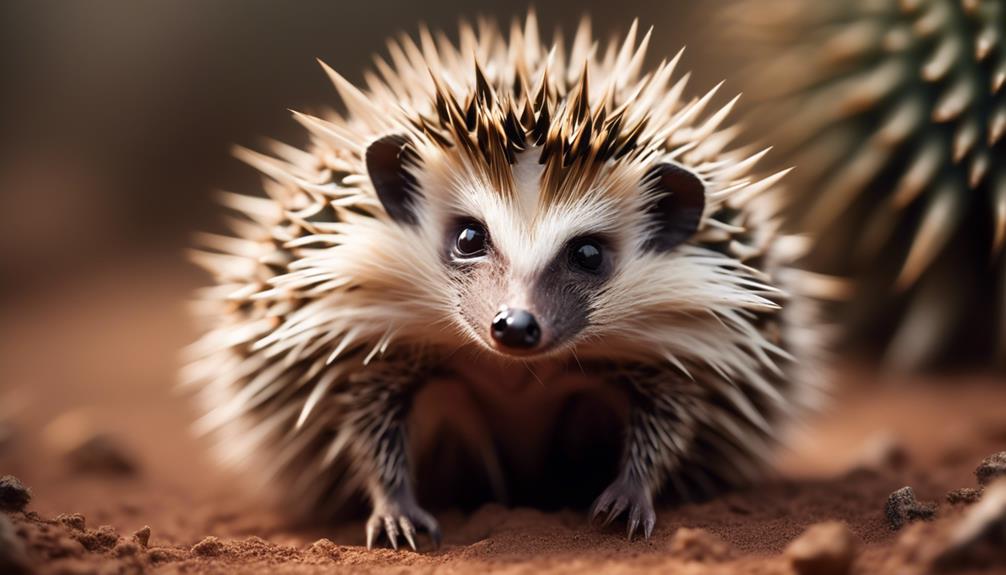
The Southern African Hedgehog, scientifically known as Atelerix frontalis, is a nocturnal and solitary mammal found in the savannas, grasslands, and woodlands of southern Africa. These spiky creatures have adapted to their diverse habitats and play an important ecological role.
They mainly feed on insects, small vertebrates, and plant matter, making them vital insectivores and contributing to the control of insect populations. Additionally, Southern African Hedgehogs aid in seed dispersal through their feces and provide prey for larger predators.
Their presence in an ecosystem can also serve as an indicator of its overall health. With their unique physical characteristics, including their ability to roll into a ball for protection, they have successfully survived and thrived in their natural habitats.
Habitat and Behavior of Southern African Hedgehogs
Southern African Hedgehogs are adapted to thrive in a range of habitats, including savannas, grasslands, and woodlands. Their habitat and behavior make them intriguing creatures to study.
Here are three fascinating facts about their habitat and behavior:
- Nocturnal Lifestyle: Southern African Hedgehogs are primarily active at night, using their excellent sense of smell to locate prey such as insects and small vertebrates. Their solitary nature allows them to navigate their environment undisturbed.
- Burrow Dwellers: These hedgehogs are proficient diggers, using their strong claws to create burrows for shelter and protection. These burrows serve as their homes, providing a safe space to rest during the day.
- Spiky Defense Mechanism: When feeling threatened, Southern African Hedgehogs curl up into a tight ball, with their spines acting as a formidable defense against predators. This unique adaptation allows them to ward off potential threats effectively.
Conservation Status of Southern African Hedgehogs
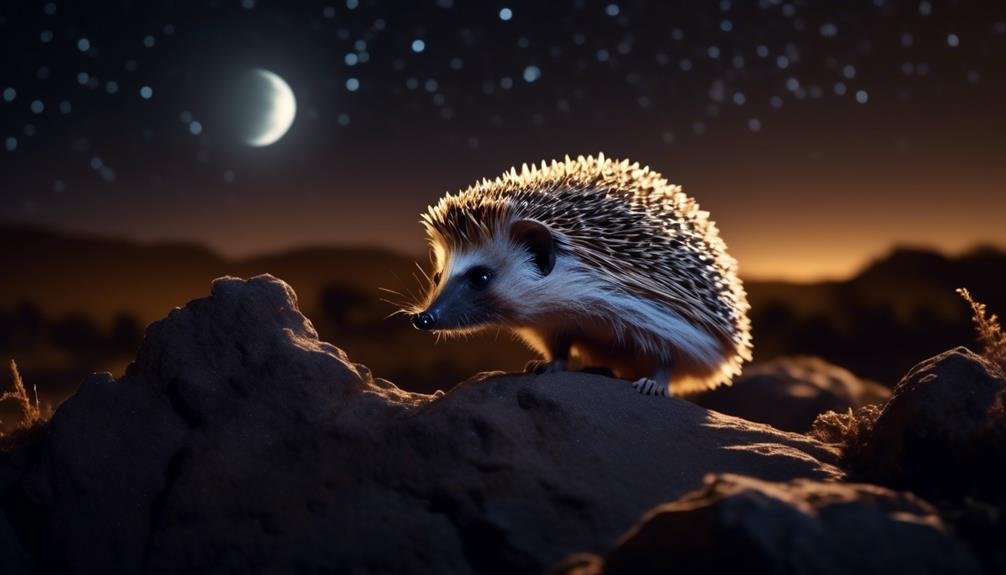
As we shift our focus to the conservation status of the Southern African Hedgehog, it is essential to recognize the significance of protecting these spiky guardians of the region.
Currently, the Southern African Hedgehog is listed as Least Concern on the IUCN Red List, indicating that its population is stable and there are no major threats identified. This is largely due to their presence in protected areas and national parks.
However, it is crucial to continue conservation efforts, particularly in terms of habitat preservation. Southern African Hedgehogs play an important ecological role as insectivores, helping to control insect populations and aiding in seed dispersal through their feces. Furthermore, they provide prey for larger predators and can serve as indicators of ecosystem health.
Thus, safeguarding their populations is crucial for maintaining the balance and health of the region’s ecosystems.
Physical Characteristics of Southern African Hedgehogs
Covered in a dense layer of protective spines, the Southern African Hedgehog possesses physical characteristics that are crucial for its survival in the diverse habitats of southern Africa. These enigmatic creatures have adapted to their environment in the following ways:
- Spines: The hedgehog’s spines serve as a formidable defense mechanism, deterring potential predators and providing excellent camouflage in the vegetation.
- Rolling into a ball: When threatened, the hedgehog can curl up into a tight ball, with its spines forming an impenetrable barrier, leaving only its spiky exterior exposed.
- Fur color and features: With a pointed snout and small eyes, the hedgehog’s fur color can vary from light brown to dark brown, allowing it to blend seamlessly into its surroundings.
These physical characteristics not only aid in the hedgehog’s survival but also evoke a sense of wonder and admiration for these enigmatic spiky guardians of southern Africa.
Reproduction of Southern African Hedgehogs
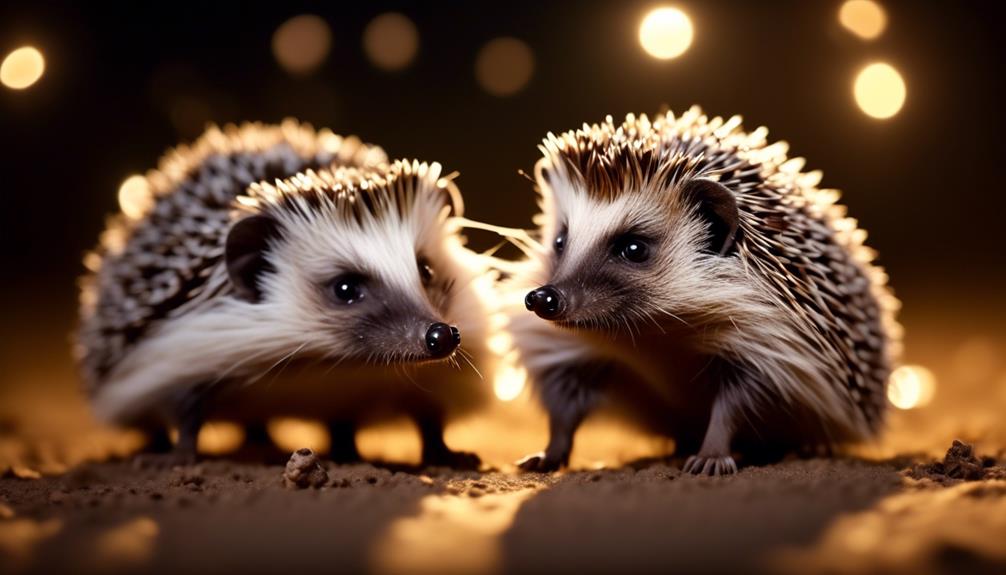
Reproduction plays a vital role in the lifecycle of the Southern African Hedgehog, contributing to the sustainability of their population in the diverse habitats of southern Africa.
Breeding season varies by region, and the gestation period lasts around 35 days. Female hedgehogs give birth to 2-4 young, which are born blind and hairless. These young hedgehogs rely on their mother for nourishment and protection until they reach sexual maturity at around 6-8 months.
This reproductive strategy ensures the continuation of the species and allows for the colonization of new areas. By producing offspring, Southern African Hedgehogs contribute to the overall ecological balance of their habitats, as they serve as important insectivores and play a role in nutrient cycling and seed dispersal.
The Ecological Role of Southern African Hedgehogs
Southern African Hedgehogs play a crucial ecological role in their habitats, contributing to the overall balance and health of the ecosystem. They are not just adorable creatures, but also serve as important contributors to the intricate web of life.
Here are three ways in which these spiky guardians make a difference:
- Insect Control: Hedgehogs are voracious insectivores, feeding on a variety of insects. By preying on insects, they help control their populations, preventing outbreaks and maintaining the delicate balance of the ecosystem.
- Seed Dispersal: Hedgehogs aid in seed dispersal through their feces. As they move around, they inadvertently carry seeds from one place to another, promoting plant diversity and helping plants colonize new areas.
- Prey for Predators: Hedgehogs serve as prey for larger predators, such as birds of prey and carnivorous mammals. By providing a food source for these predators, hedgehogs contribute to the stability of the food chain and the survival of other species.
Southern African Hedgehogs as Insect Controllers
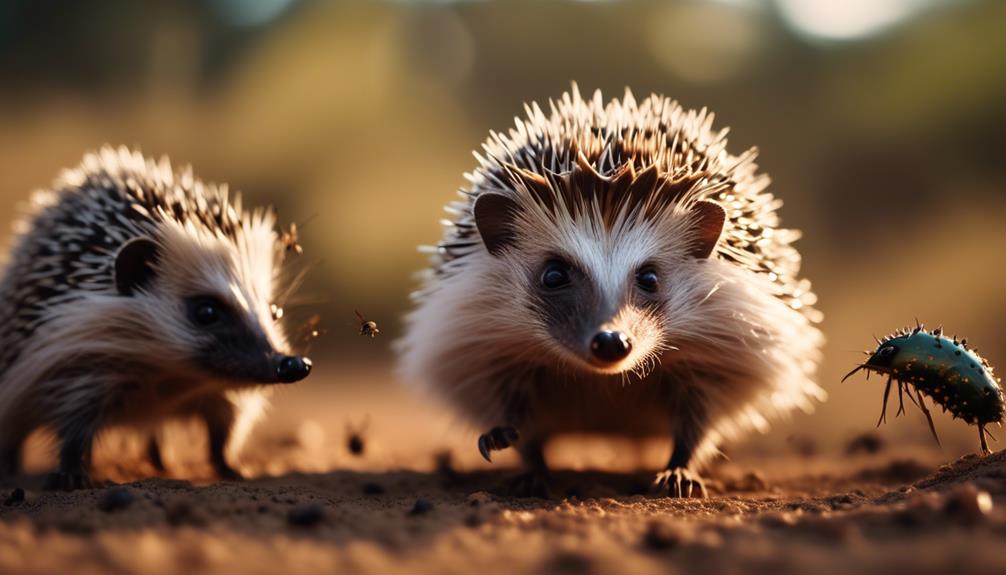
Southern African Hedgehogs play a crucial role in controlling insect populations within their habitats. These spiky creatures are skilled insectivores, feeding on a variety of insects such as beetles, grasshoppers, and caterpillars. By consuming these insects, hedgehogs help to regulate their populations and prevent outbreaks that could have detrimental effects on the ecosystem. To better understand their role as insect controllers, let’s take a look at the following table:
| Insects consumed by Southern African Hedgehogs | Examples of insects |
|---|---|
| Beetles | Ladybugs, weevils |
| Grasshoppers | Locusts, crickets |
| Caterpillars | Armyworms, loopers |
Through their voracious appetites, Southern African Hedgehogs contribute to maintaining a balanced ecosystem by keeping insect populations in check. Their important role as insect controllers highlights the significance of these enigmatic creatures in the habitats they inhabit.
Southern African Hedgehogs as Seed Dispersers
What role do Southern African Hedgehogs play in seed dispersal within their habitats?
Southern African Hedgehogs, in addition to their role as insect controllers, also contribute to the dispersal of seeds within their habitats. Through their feeding habits and digestive system, these spiky guardians inadvertently aid in the propagation of plant species.
Here are three ways in which Southern African Hedgehogs act as seed dispersers:
- Accidental seed consumption: Hedgehogs consume fruits and berries as part of their diet. In the process, they unknowingly ingest seeds, which are then transported to different locations through their digestive system.
- Seed deposition in feces: After digestion, the seeds are excreted in the hedgehogs’ feces. These droppings serve as fertilizer for the seeds, enhancing their chances of germination and growth.
- Seed dispersal through movement: As hedgehogs roam and forage within their habitats, they inadvertently disperse seeds by depositing them in different areas through their fecal droppings.
The role of Southern African Hedgehogs as seed dispersers highlights their importance in maintaining the biodiversity and ecosystem dynamics of their habitats.
The Importance of Southern African Hedgehogs in Ecosystem Health
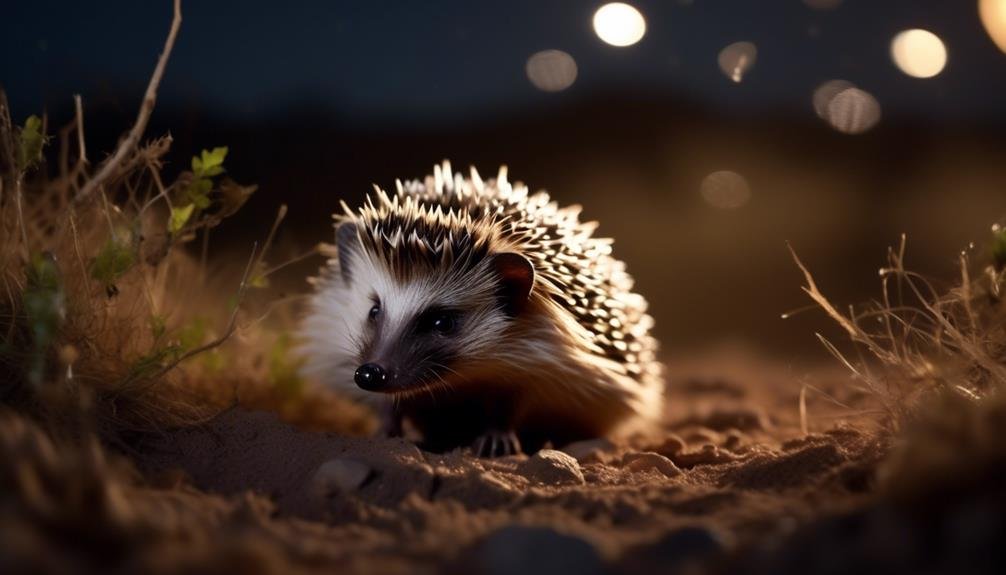
Hedgehogs in southern Africa play a crucial role in maintaining the health and balance of their ecosystems. These spiky creatures are important insectivores, helping to control insect populations. By feeding on insects, they help to keep their numbers in check and prevent them from becoming pests.
Additionally, hedgehogs aid in seed dispersal through their feces. As they move through their habitats, they consume fruits and seeds and then deposit them in different areas, contributing to plant diversity and regeneration.
Hedgehogs also serve as prey for larger predators, such as birds of prey and carnivores, helping to sustain the food chain. Furthermore, these small mammals can serve as indicators of ecosystem health. Their presence or absence can provide valuable information about the overall condition of their habitats.
Frequently Asked Questions
How Do Southern African Hedgehogs Protect Themselves From Predators?
Southern African hedgehogs protect themselves from predators by curling into a ball, using their spines as a defense mechanism. When threatened, they roll up, exposing only their spiky exterior, making it difficult for predators to attack.
What Is the Average Lifespan of a Southern African Hedgehog?
The average lifespan of a southern African hedgehog, scientifically known as Atelerix frontalis, is not well-documented. More research is needed to determine the exact lifespan of these enigmatic spiky guardians of southern Africa.
How Do Southern African Hedgehogs Communicate With Each Other?
Southern African hedgehogs communicate through a variety of methods, including vocalizations, body language, and scent marking. They use hissing and clicking sounds, as well as postures like raising their spines and puffing up their bodies, to convey messages to other hedgehogs.
Do Southern African Hedgehogs Have Any Natural Predators?
Southern African hedgehogs have natural predators, including birds of prey, snakes, and larger mammals like mongooses and jackals. However, their spiky exterior and ability to roll into a ball provide them with protection against many potential threats.
Are Southern African Hedgehogs Found in Any Other Regions Besides Southern Africa?
Southern African hedgehogs, scientifically known as Atelerix frontalis, are primarily found in southern Africa. They are not known to occur in any other regions besides southern Africa.
What are the similarities and differences between Southern African hedgehogs and African Pygmy hedgehogs?
Southern African hedgehogs and African Pygmy hedgehogs share similarities in diet and behavior. Both are insectivores and solitary creatures. However, they differ in size and coloration. The fascinating African Pygmy hedgehogs are smaller and often have a more varied color palette compared to their southern counterparts.
Conclusion
In conclusion, the southern African hedgehog plays a crucial ecological role in its habitats. With its spiky appearance and diverse diet, it is an important species in southern Africa. Despite being listed as Least Concern on the IUCN Red List, conservation efforts focused on habitat preservation are essential for the long-term survival of these enigmatic creatures.
As insect controllers and seed dispersers, southern African hedgehogs contribute to ecosystem health in southern Africa. Their presence in protected areas and national parks ensures their stability and contributes to the overall balance of the ecosystem.

